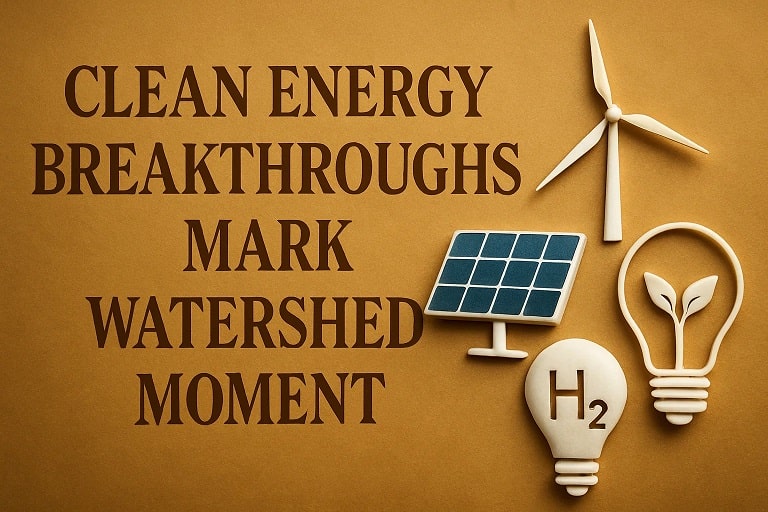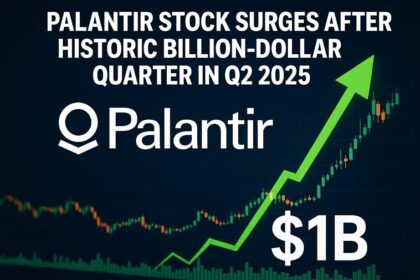Clean Energy Breakthroughs Mark Watershed Moment: Innovations Accelerating Global Transition
In 2025, clean energy breakthroughs have reached a watershed moment, with investments surging to record highs, technological patents exploding, and deployment scaling at unprecedented rates. From China’s dominance in EV batteries and solar panels to US advancements in battery storage and AI-driven grid management, these innovations signal a tipping point in the global shift to renewables. As highlighted by the International Energy Agency (IEA) and World Economic Forum, clean energy investment hit $500 billion in solar alone last year, outpacing fossil fuels, while breakthroughs in sodium-ion batteries, fusion progress, and sustainable aviation fuel (SAF) promise to slash emissions further. This article explores the key drivers behind these advancements, their historical evolution, future trajectories, and profound impacts, with a focus on India’s role and Tamil Nadu’s contributions as a manufacturing and tech hub.
Why This Watershed Moment Matters
The year 2025 represents a convergence of plummeting costs—solar down 80% since 2010—and policy momentum, like the US Inflation Reduction Act and China’s “Made in China 2025” initiative, which has propelled Beijing to lead in 95% of clean energy patents. These breakthroughs not only address climate goals but also enhance energy security amid geopolitical tensions. For India, aiming for 500 GW renewables by 2030, this moment offers opportunities in battery production and solar exports, with Tamil Nadu’s Chennai and Coimbatore emerging as key players in EV and solar manufacturing, potentially adding ₹10,000 crore to the state’s GDP.
Latest Developments Driving the Breakthroughs
2025 has seen a flurry of clean energy milestones, driven by surging investments ($1.8 trillion globally in 2024) and technological leaps. Key highlights include:
- China’s Patent Surge: Chinese applicants filed over 5,000 high-quality clean energy patents in 2022 alone, dominating EVs, batteries, and solar. Innovations like 5-minute EV charging systems from BYD and Great Wall Motor erase range anxiety, while rare earth magnet export restrictions ensure supply chain control.
- US Battery and Storage Boom: The US Energy Information Administration projects 18.2 GW of new battery storage in 2025, tripling 2023 levels. Breakthroughs in flow batteries and lithium-ion alternatives enable days-long storage, supporting AI data centers’ 44 GW demand by 2030.
- Sodium-Ion Batteries: BLUETTI’s Pioneer Na, unveiled at IFA Berlin 2025, operates at -25°C with 1,500W output, using abundant sodium for cheaper, safer alternatives to lithium-ion, ideal for cold climates and India’s rural electrification.
- Sustainable Aviation Fuel (SAF): Australia’s ARENA funds $8 million for sugarcane waste-to-SAF at Isis Central Sugar Mill, potentially supplying Brisbane Airport. China’s policy mandates SAF blending, cutting aviation emissions by 80%.
- Nuclear and Fusion Revival: AI’s energy demands revive nuclear interest, with small modular reactors (SMRs) and fusion startups like Proxima Fusion advancing. The EU leads in net-zero innovation but faces high energy costs; Poland enters nuclear as a newcomer.
Tamil Nadu’s Context
Tamil Nadu, with its 10 GW solar capacity and EV hubs like Chennai’s Foxconn plant, is leveraging these breakthroughs. The state’s Vikram Solar and sodium-ion R&D could export to China’s market, while Coimbatore’s startups integrate SAF tech for aviation, aligning with IMC 2025’s rural tech focus.
Historical Context of Clean Energy Progress
Clean energy’s evolution from niche to mainstream spans decades, marked by policy shifts and tech leaps:
- 1970s-1980s: Oil crises spurred early solar and wind R&D; US Energy Policy Act of 2005 incentivized renewables.
- 2000s: China’s “Made in China 2025” (2015) flooded markets with cheap solar, dropping costs 80%; Bt cotton and early EVs emerged.
- 2010s: Lithium-ion batteries revolutionized storage; global solar capacity grew 12-fold.
- 2020s: Pandemic accelerated EV adoption; China overtook US in patents (5,000 in 2022 vs. 18 in 2000); US IRA (2022) boosted $272 billion investments in 2024.
- 2025: Exascale computing like JUPITER aids climate modeling; sodium-ion and SAF breakthroughs mark commercialization.
This trajectory shows a shift from subsidies to market dominance, with India’s 50% renewable capacity increase in 2023 positioning Tamil Nadu as a solar leader.
Future Scopes and Projections
By 2030, clean energy could meet 50% of global demand, with $10 trillion annual investments. Projections include:
- Solar and Storage: Global solar hits 1 TW; India’s 500 GW target drives Tamil Nadu’s exports to $5 billion.
- EVs and Batteries: 5-minute charging standardizes; sodium-ion cuts costs 30%, benefiting India’s 30% EV goal.
- SAF and Hydrogen: Aviation emissions drop 80%; India’s green hydrogen mission scales to 5 MMT.
- Nuclear/Fusion: SMRs deploy in Poland/France; fusion pilots by 2030, with India’s BARC contributing.
Long-Term Strategic Outlook
By 2035, net-zero grids prevail; Tamil Nadu could lead in sodium-ion manufacturing, adding ₹20,000 crore to GDP. Challenges: Supply chain vulnerabilities (China’s 60% solar dominance) and policy uncertainty (US tariffs). India’s PLI scheme counters this, with Tamil Nadu’s incentives attracting $2 billion FDI.
Impacts on the Indian Economy and Stakeholders
These breakthroughs could add $1 trillion to India’s GDP by 2030, with Tamil Nadu at the forefront.
Sector-Wise Impacts
Solar and Renewables
- Impact: Cost drops enable 1 TW global capacity; Tamil Nadu’s Vikram Solar scales to 10 GW.
- Economic Contribution: ₹15,000 crore to GDP, with Tamil Nadu at 20%.
- Business Opportunities: Coimbatore firms export panels to China/EU.
EVs and Batteries
- Impact: Sodium-ion adoption cuts costs; Chennai’s Foxconn produces 20 million EVs annually.
- Economic Contribution: ₹10,000 crore, with Tamil Nadu contributing 30%.
- Business Opportunities: Startups develop 5-minute chargers.
Aviation and SAF
- Impact: Sugarcane waste SAF reduces emissions 80%; Tamil Nadu’s mills pilot production.
- Economic Contribution: ₹5,000 crore in exports.
- Business Opportunities: Coimbatore integrates SAF for regional flights.
Breakthroughs Snapshot
| Breakthrough | Technology | Tamil Nadu Impact |
|---|---|---|
| Sodium-Ion Batteries | BLUETTI Pioneer Na | Chennai EV manufacturing boost |
| SAF from Waste | Sugarcane SAF | Madurai mills for aviation fuel |
| 5-Min EV Charging | BYD/Great Wall | Coimbatore charging infrastructure |
| Market Size (2030) | $10T Global Clean Energy | ₹50,000 crore from Tamil Nadu |
Frequently Asked Questions (FAQs)
What defines 2025’s clean energy watershed?
Surge in patents (China’s 5,000+), investments ($500B solar), and breakthroughs like sodium-ion batteries and SAF.
How does China lead?
Dominates 95% of clean patents, EVs, and solar; “Made in China 2025” drives exports.
What’s Tamil Nadu’s role?
Solar (10 GW), EV manufacturing (Foxconn), and SAF pilots contribute ₹50,000 crore by 2030.
What challenges remain?
Supply chains (China’s dominance), policy uncertainty (US tariffs), and scaling fusion/SMRs.
How do these impact India?
Accelerate 500 GW renewables goal, creating 1 million jobs, with Tamil Nadu leading exports.












